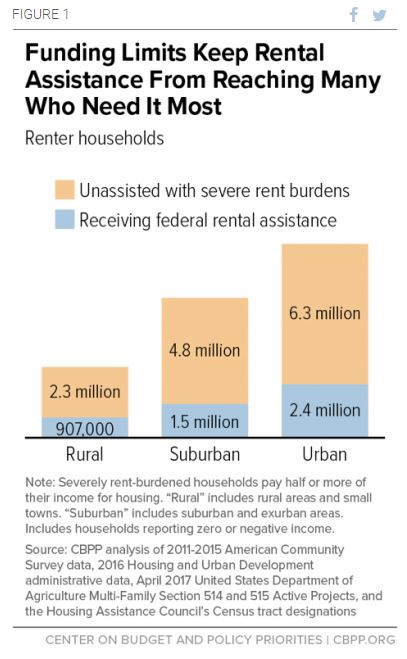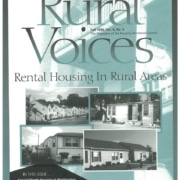HAC News Formats. pdf
September 2, 2015
Vol. 44, No. 18
• Administration asks for permission to spend more rural Rental Assistance early in FY16 • Some RA contracts running out of funds early cannot be renewed • House’s FY16 appropriations bills exceed caps set in budget deal • HUD offers ICDBG funds • Grants available for domestic violence HIV/AIDS housing • USDA reports on review of Section 523 self-help TA • Comment period reopened for RD economic and community development setaside • CDFI Program interim rule issued • HUD corrects errors in AFFH and voucher portability rules • Report reviews progress in Texas colonias
HAC News Formats. pdf
September 2, 2015
Vol. 44, No. 18
ADMINISTRATION ASKS FOR PERMISSION TO SPEND MORE RURAL RENTAL ASSISTANCE EARLY IN FY16. The White House has requested a number of “anomalies” – changes from FY15 appropriations – it wants Congress to include in a Continuing Resolution that would fund the government in early FY16. The list includes one rural housing item, asking that Section 521 Rental Assistance funds “may be apportioned up to the rate for operations necessary to pay ongoing debt service for the section 514 and 515 multifamily direct loan programs.” Noting that “the timing of contract renewals has shifted heavily to the first few months of the fiscal year,” the Administration wants to be able to spend a disproportionate amount of RA dollars at the beginning of the fiscal year. It does not ask for additional funding.
SOME RA CONTRACTS RUNNING OUT OF FUNDS EARLY CANNOT BE RENEWED. Under the FY15 appropriations act, Section 521 RA contracts dated December 16, 2014 or later cannot be renewed early if they use up their funding before their full 12-month terms (see HAC News, 12/10/14). USDA RD estimates that in FY15, 50 properties will run out of RA money before their terms end, and that in early FY16, 700-800 projects will be affected. Owners can ask RD for the mitigation measures offered at the end of FY13, such as deferral of RD payments (see HAC News, 10/1/13), but when those changes are not enough to cover operating costs RD staff reportedly are telling property owners they can request permission to raise rents. The National Housing Law Project has informed RD that raising rents in this situation is illegal. HAC is offering to share information among owners and others; please send contact information to Leslie Strauss, HAC, leslie@ruralhome.org, 202-842-8600, and identify any specific properties in this situation.
HOUSE’S FY16 APPROPRIATIONS BILLS EXCEED CAPS SET IN BUDGET DEAL. The Office of Management and Budget calculates that, if the spending limits enacted in the 2011 Budget Control Act are not raised, the House’s funding levels for FY16 would result in sequestration of $1.8 billion in non-defense spending and $3 million in defense. The Senate’s bills would require sequestration of $1 million in defense spending.
HUD OFFERS ICDBG FUNDS. Indian tribes and tribal organizations can apply by October 14 for Indian Community Development Block Grants. Contact Gloria N. Green, HUD.
GRANTS AVAILABLE FOR DOMESTIC VIOLENCE HIV/AIDS HOUSING. October 23 is the deadline for states, units of local government, and nonprofits to request funds to provide housing assistance and supportive services to low-income persons living with HIV/AIDS who need housing assistance as a result of sexual assault, domestic violence, dating violence, or stalking, and for whom emergency shelter services or other crisis intervention services are unavailable or insufficient. Contact Amy Palilonis, HUD, 202-402-5916.
USDA REPORTS ON REVIEW OF SECTION 523 SELF-HELP TA. A recent internal review of the Section 523 Mutual Self-Help Technical Assistance Grant Program, summarized in AN 4789 (August 13, 2015), found that overall the program performed well. Some of the “areas of concern” that “must be addressed” are self-help homes built with limited homeowner sweat equity due to factors other than reduced property values; grant extensions for reasons the agency believes should have been within the grantee’s control; and grantee failure to use construction contracts for subcontracted work that clearly identify the work to be completed, specifications, price, and payments. Contact a Regional Technical and Management Assistance contractor.
COMMENT PERIOD REOPENED FOR RD ECONOMIC AND COMMUNITY DEVELOPMENT SETASIDE. Comments are due September 18 on an interim rule setting aside 10% of funds from some RD non-housing programs for projects that help implement development plans (see HAC News, 5/27/15). Contact Farah Ahmad, RBS, 202-245-1169.
CDFI PROGRAM INTERIM RULE ISSUED. Comments are due October 30 on changes implementing the Uniform Administrative Requirements, Cost Principles, and Audit Requirements for Federal Awards published in December 2014 (see HAC News, 12/22/14) and making technical corrections and other updates. Contact Amber Kuchar, CDFI Fund.
HUD CORRECTS ERRORS IN AFFH AND VOUCHER PORTABILITY RULES. There was a typographical error in the final rule on Affirmatively Furthering Fair Housing (see HAC News, 7/8/15) and some text was missing from the Housing Choice Voucher portability process regulation (see HAC News, 8/19/15).
REPORT REVIEWS PROGRESS IN TEXAS COLONIAS. Las Colonias in the 21st Century: Progress along the Texas-Mexico Border, published by the Dallas Federal Reserve Bank, focuses on infrastructure, housing, economic opportunity, education, and health in the six Texas counties with the highest concentrations of colonias. The vast majority of residents (96%) characterize themselves as Hispanic or Latino, almost two-thirds are U.S. citizens, and more than 40% are poor. A shortage of decent, affordable housing remains, but the report highlights housing successes by community-based nonprofits.
 A crisis is building for many federally supported rental properties, which are an important source of affordable housing for low-income rural residents. Particularly, USDA Section 515 mortgages are nearing the ends of their terms, and property owners may wish to convert their properties to other uses (for example, market-rate housing) or sell them to others who will convert them. If owners sell to entities that will continue to use them as affordable rentals, rural tenants benefit and the existing federal investment in these properties is protected. Yet many owners are reluctant to sell their properties for preservation because they will experience adverse tax consequences at sale. This paper explores those tax consequences, indicates where they may have the greatest impact, and suggests ways they might be mitigated in order to encourage preservation.
A crisis is building for many federally supported rental properties, which are an important source of affordable housing for low-income rural residents. Particularly, USDA Section 515 mortgages are nearing the ends of their terms, and property owners may wish to convert their properties to other uses (for example, market-rate housing) or sell them to others who will convert them. If owners sell to entities that will continue to use them as affordable rentals, rural tenants benefit and the existing federal investment in these properties is protected. Yet many owners are reluctant to sell their properties for preservation because they will experience adverse tax consequences at sale. This paper explores those tax consequences, indicates where they may have the greatest impact, and suggests ways they might be mitigated in order to encourage preservation.


